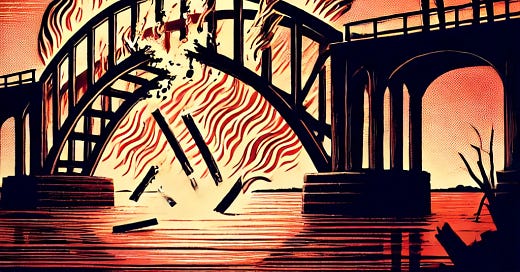When you think about it, bridges are pretty important. Okay, maybe you already know that without having to stop and think about it, but I mean: they’re kind of part and parcel with civilization.
Bridges connect one thing to another, allowing safe passage to the other side. They cross rivers and gorges, and once the incredibly hard work of building a bridge is complete, many people (sometimes many generations) can reap the rewards of connectivity and freer movement.
Naturally, burning a bridge means destroying this metaphorical (and real) link to the other side of the ravine, where the other people are. When we say that it’s bad to burn bridges, it’s because you can never go back once you’ve undone all that work.
Likewise, if you’ve just crossed a body of water with a ship, you will probably need that same ship to get back from where you came.
Isn’t it odd, then, that we say burning the ships can be good?
Here’s one story about how that came to be that way:
Hernán Cortés, driven by an unquenchable thirst for success, stood at a pivotal crossroads in 1519.
He and his men, weathered by the relentless challenges of a perilous ocean voyage, had finally reached the shores of what would be known as Mexico. Cortés, fueled by a potent blend of personal ambition and a quest for glory, was acutely aware of the immense riches and potential power that lay within this uncharted land.
His eyes, reflecting a blend of weariness and unyielding determination, mirrored the ambitions of a man set on carving his name into the annals of history. The promise of wealth, the allure of political power, and the competitive spirit of the Age of Exploration coursed through his veins.
But Cortés’s men were exhausted and scared. Many of them wanted to return home.
That’s when Cortés ordered the ships burned.
Cortés really did destroy those ships—he just didn’t have them burned, as the legend (and now the common phrase as well) has it. Instead the ships were scuttled (sunk), so the end effect was the same: there was no way back home.
It shouldn’t matter whether it’s a bridge or a ship; if you burn it, you’re implicitly closing a pathway back home. You’re saying to the world that you are ready to head into uncertainty, and this is the only possible way forward.
If you burn ships, it’s a good idea. If you burn bridges, it’s a bad idea.
Language, what gives?!?
While it’s true that both bridges and ships can get you to the other side, there’s one very substantive difference between the two. In most cases, if you cross a bridge, someone else can cross the other way. In other words, bridges are more like reciprocal connectors than one-way trips.
By contrast, a ship clearly takes only people who are supposed to be on the ship (stowaways excluded!) across, and there’s certainly no simultaneous passage both ways across a ship (as there might be with a bridge).
In the mind of the listener, burning a bridge implies that neither side gets to use that portal any more. Burning ships, on the other hand, means only you are stuck here.
The idea of destroying only your passageway back is different than destroying a relationship, which is one common way you’ll hear burning bridges. Instead, burning ships is all about you and your life.
Burning ships is something I’ve practiced in my own life, and if you’re curious about that, you might enjoy reading this next:
Burning the Ships
Hernán Cortés, driven by an unquenchable thirst for success, stood at a pivotal crossroads in 1519.







Annals of history heheh
While we’re traversing the water theme, consider what it means to be up a certain creek without a paddle.